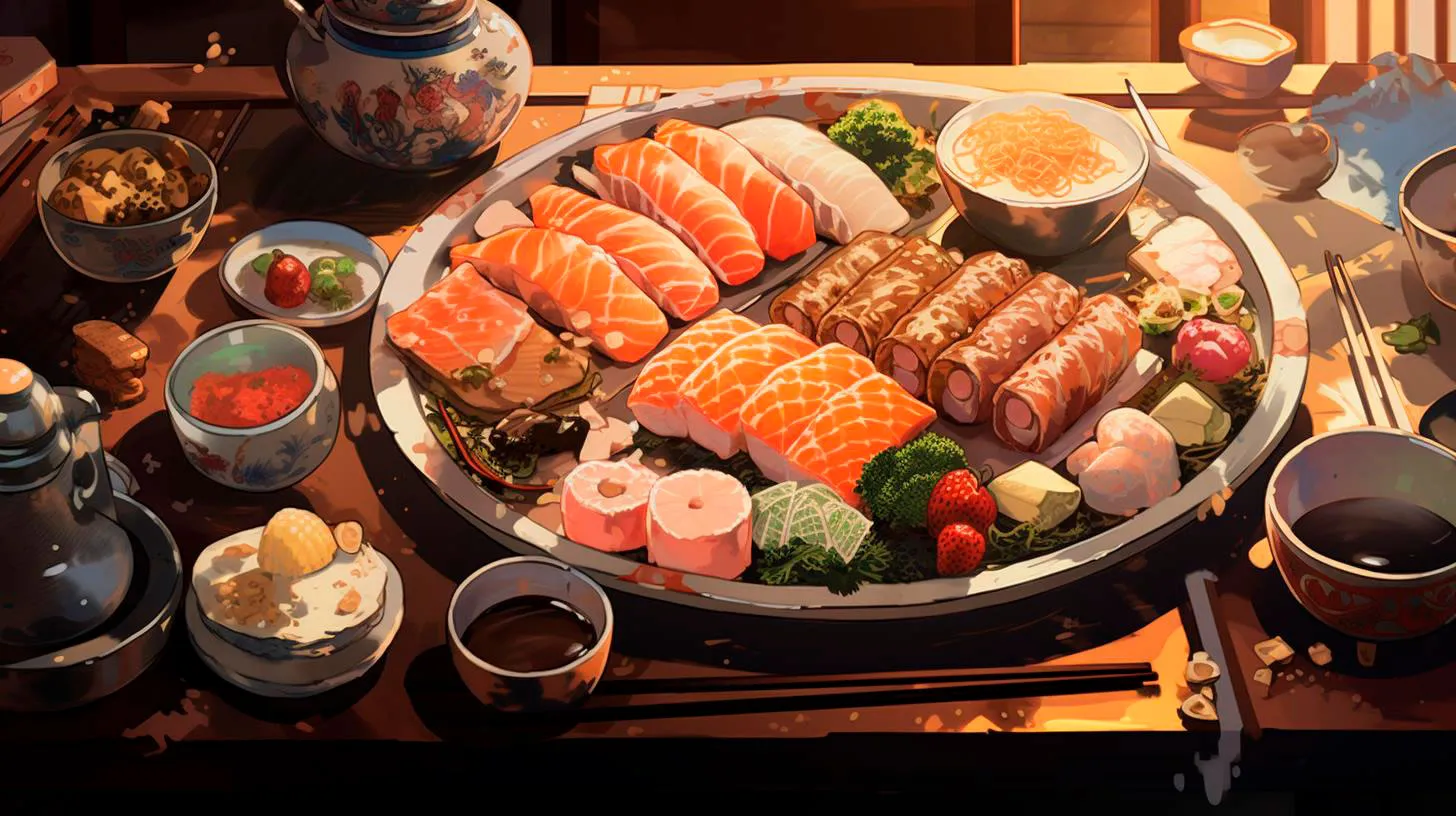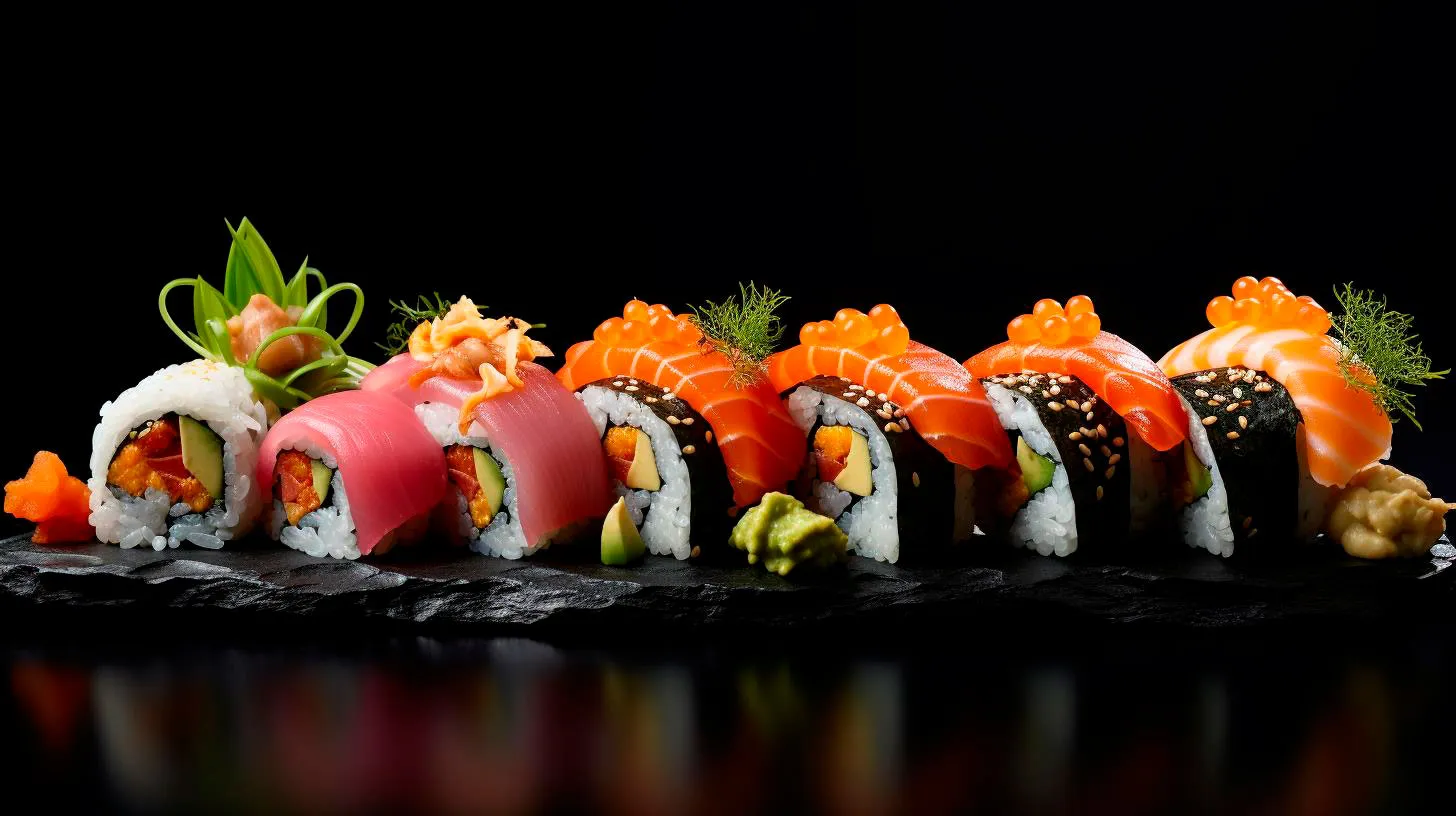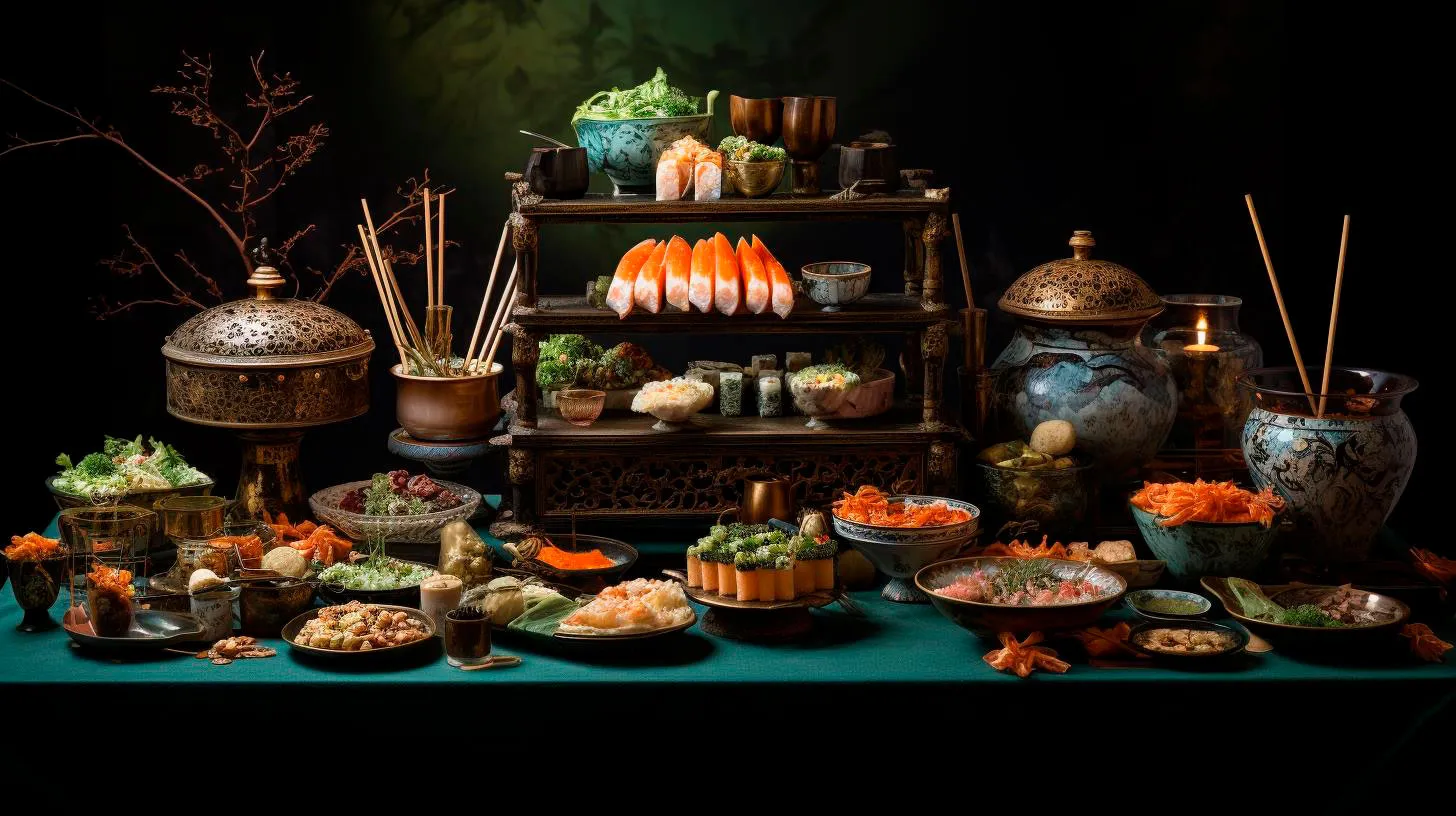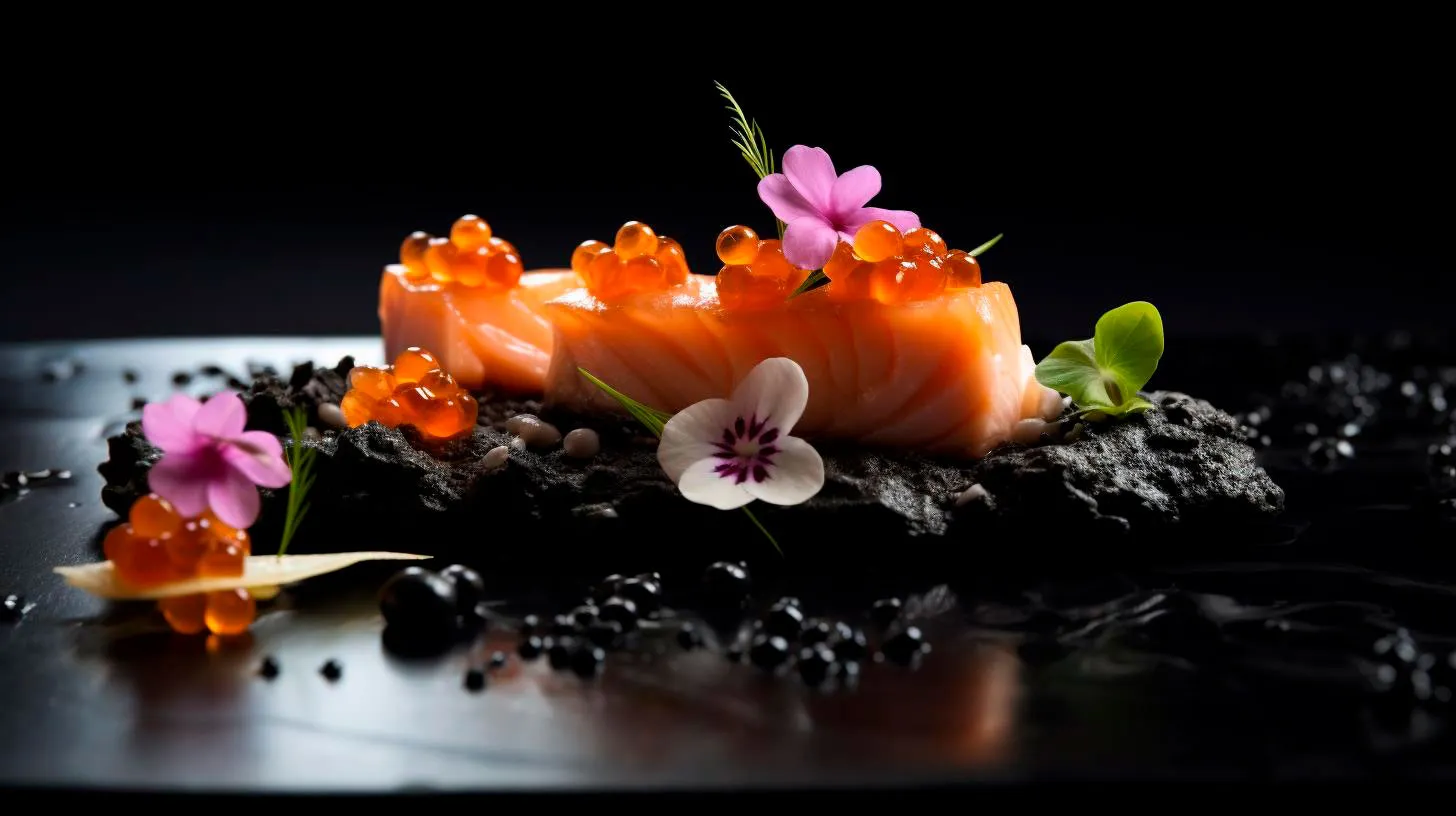The Intricacy of Sushi Art: A Captivating Journey into Culinary Creativity
In this article, we will explore the intricacies of sushi art, diving into the fascinating world of culinary creativity.
The Art of Sushi Craftsmanship
Sushi-making is far more than just assembling ingredients. It is a meticulous process that demands precision, patience, and a deep understanding of flavors. From the selection of the freshest fish to the proper mixing of vinegared rice, every step in sushi preparation is essential to achieving a harmonious balance of taste and texture.
Let’s delve into the various aspects that make sushi a unique culinary art form:
1. Ingredient Selection:
The quality and freshness of ingredients are paramount in sushi-making. Sushi chefs meticulously handpick the finest fish, ensuring they are sustainably sourced and meet the highest standards. The attention to detail extends to the selection of vegetables, seaweed, and condiments, resulting in a delightful sensory experience.
2. Rice Mastery:
The foundation of any good sushi lies in the rice. Sushi rice, seasoned with vinegar, sugar, and salt, requires skillful handling to achieve the perfect texture and flavor. Each grain should retain its shape while being subtly infused with the tanginess of the seasoning.
3. Knife Skills:
Sushi chefs spend years honing their knife skills, which are vital for precise cutting techniques. From expertly slicing raw fish into thin, uniform pieces to crafting intricate garnishes, the mastery of a sharp knife is the cornerstone of sushi preparation.
4. Presentation:
One of the most captivating aspects of sushi art is its presentation. Using an array of vibrant ingredients, sushi chefs meticulously arrange each piece to create visually stunning dishes. From sophisticated nigiri sushi to beautifully rolled maki, the eye-catching presentation enhances the overall dining experience.
Sushi Artistry around the World
As sushi gained popularity globally, it evolved to incorporate local ingredients and flavors, giving rise to unique interpretations of this traditional Japanese delicacy. Let’s take a look at some prominent sushi styles:
1. Nigiri Sushi:
- Hand-formed sushi with a slice of fresh fish on vinegared rice.
- Purest form of sushi, allowing the fish to take center stage.
- Key Takeaway: Simple elegance and the pursuit of culinary perfection.
2. Maki Sushi:
- Sushi rolls wrapped in seaweed (nori) or thin omelet (tamago).
- Offers endless flavor combinations and artistic possibilities.
- Key Takeaway: Creative fusion and versatility.
3. Temaki Sushi:
- Hand-rolled cone-shaped sushi filled with various ingredients.
- Perfect for interactive dining experiences.
- Key Takeaway: Casual and customizable.
These are just a few examples of sushi styles that have captured the hearts and taste buds of people around the world. Whether you are savoring traditional nigiri or indulging in innovative sushi creations, each piece offers a glimpse into the culinary imagination of the sushi chef.
The Rise of Sushi as an International Delicacy
The popularity of sushi has skyrocketed in the past few decades. Let’s take a look at some compelling statistics that highlight its global appeal:
- In the United States alone, sushi consumption has increased by over 50% in the last decade.
- As of 2021, the global sushi market is valued at a remarkable $22 billion.
- Japan, the birthplace of sushi, boasts over 45,000 sushi restaurants.
- The world’s largest sushi mosaic, created in Brazil, consisted of more than 30,000 sushi pieces.
These figures signify the tremendous growth and appreciation for sushi as a culinary masterpiece worldwide. Its ability to fuse tradition with innovation has allowed sushi to charm food enthusiasts of all backgrounds.
The Fascination Continues
Sushi art is a captivating journey into culinary creativity, where every bite is an experience. From the careful selection of ingredients to the meticulous presentation, sushi-making embodies the principles of precision, balance, and beauty.
As sushi continues to evolve and captivate taste buds worldwide, it remains a testament to the enduring power of culinary artistry. So next time you savor a piece of sushi, take a moment to appreciate the intricacy and passion that went into creating this gastronomic delight.
Picturing Complexity: Examining the Intricate Beauty of Sushi Art
The Artistry of Sushi
What sets sushi apart from other culinary creations is the meticulous attention to detail. Sushi chefs spend years honing their skills and perfecting their techniques. Every sushi roll is a work of art, combining a harmonious symphony of flavors, textures, and colors on a single plate.
Let’s delve deeper into the intricate beauty of sushi art and explore its noteworthy characteristics:
1. Precision and Technique
Sushi-making is a combination of art and technique. From perfectly slicing the fish to rolling the sushi with precision, every step requires skill and practice. The chefs meticulously arrange the ingredients to create visually appealing patterns and textures, often using contrasting colors to enhance the presentation.
2. Visual Aesthetics
Sushi is a feast for the eyes as much as it is for the taste buds. The artistry lies not only in the flavors but also in the visual presentation. Chefs skillfully arrange the ingredients, incorporating vibrant colors and artistic garnishes to create an aesthetically pleasing masterpiece. The use of edible flowers, microgreens, and intricate condiments adds an exquisite touch.
3. Balance of Flavors
One of the key elements of sushi art is achieving a harmonious balance of flavors. Each sushi roll is meticulously crafted to provide a delicate combination of sweetness, saltiness, acidity, and umami. The flavors are carefully balanced to create a multi-dimensional culinary experience that delights the taste buds.
4. Seasonality and Freshness
Sushi art is closely tied to the concept of seasonality. Traditional sushi masters emphasize the use of fresh, seasonal ingredients to ensure the highest quality and flavors. Each season brings its own specialties, and sushi chefs incorporate these seasonal ingredients into their creations. This emphasis on freshness ensures that every bite is a celebration of nature’s bounty.
5. Innovation and Creativity
While sushi has a rich history steeped in tradition, it also embraces innovation and creativity. Contemporary sushi chefs push the boundaries of traditional techniques and experiment with new flavors and ingredients. This fusion of tradition and innovation results in unique and exciting sushi creations that captivate diners.
Sushi Art: A Global Phenomenon
Sushi artistry is not limited to Japan alone. This culinary art form has gained popularity worldwide, captivating people from all walks of life. Let’s take a closer look at its global impact:
1. Rise of Sushi Bars
Sushi bars have sprung up across the globe, from Tokyo to New York and London to Sydney. These establishments not only serve exquisite sushi but also provide an immersive and artistic dining experience. Diners can witness the sushi-making process, appreciating the intricate techniques and awe-inspiring presentations.
2. Social Media Sensation
Sushi art has become a social media sensation, with Instagram feeds flooded with mesmerizing sushi creations. Food enthusiasts and influencers showcase these visually stunning dishes, attracting a broader audience and inspiring others to explore the world of sushi art.
3. Fusion with Local Cuisines
Across different cultures, sushi has seamlessly melded with local cuisines, resulting in innovative fusions. From sushi burritos in California to sushi tacos in Mexico, chefs have embraced the art of sushi and created unique cross-cultural culinary experiences.
4. Culinary Competitions
The growing popularity of sushi art has led to the emergence of culinary competitions dedicated to this art form. These competitions provide a platform for talented sushi chefs to showcase their creativity and skill, raising the bar for sushi craftsmanship worldwide.
The Takeaway: A Culinary Masterpiece
Sushi art exemplifies the perfect marriage of culinary expertise and artistic expression. Its intricate beauty, attention to detail, and harmonious flavors make it a true culinary masterpiece. Whether you are a sushi enthusiast or simply an appreciator of fine art, exploring the world of sushi art is an experience that should not be missed.
Indulge in the symphony of flavors, immerse yourself in the visual aesthetics, and savor the craftsmanship of sushi art. Let each bite transport you to a world of intricate beauty and culinary marvels.
Unveiling the Complexity: Exploring the Artistry Behind Sushi Masterpieces
In this article, we will dive deep into the complexity and artistry behind sushi masterpieces, taking a closer look at their techniques, ingredients, and cultural significance.
Techniques that Define Sushi Excellence
Creating a sushi masterpiece requires years of dedication, practice, and a profound understanding of the craft. Sushi Masters train rigorously under expert guidance to master the following techniques:
- Slicing Techniques: Sushi Masters meticulously slice fish and other ingredients to precise dimensions, ensuring a perfect bite in every morsel. Their ability to control the angle, pressure, and speed of the blade is essential for achieving the desired texture and flavor.
- Sushi Rice Preparation: The foundation of sushi lies in the expertly seasoned vinegared rice. Sushi Masters have honed their skills to achieve the perfect balance between the stickiness, temperature, and seasoning of the rice.
- Rolling Techniques: Whether it’s the iconic Maki rolls or delicate hand-pressed Nigiri, Sushi Masters possess the art of rolling sushi with precision. Their adeptness in shaping, filling, and wrapping the ingredients guarantees an enticing visual appeal.
By mastering these techniques, Sushi Masters elevate their creations to awe-inspiring levels, making each bite a delightful experience.
The Art of Ingredients
Behind every exceptional sushi masterpiece lies a carefully curated selection of ingredients. The key to their success lies in sourcing the freshest seafood, utilizing local produce, and presenting flavor combinations that evoke a sensory journey. Here are some remarkable aspects of sushi ingredients:
- Impeccable Seafood: Sushi Masters select only the finest, sustainably sourced seafood to ensure the utmost quality and freshness. From tender tuna to buttery salmon, each piece of fish is meticulously inspected, ensuring a sumptuous experience for the diner.
- Seasonal Accents: Sushi Masters pay homage to Japan’s rich culinary heritage by incorporating seasonal ingredients into their creations. The use of delicate cherry blossoms in spring or flavorsome matsutake mushrooms in autumn adds a touch of artistry and celebrates nature’s bounty.
- Wasabi and Soya Sauce: These condiments play a vital role in sushi appreciation. Sushi Masters skillfully balance the spiciness of wasabi and the savory umami flavor of soya sauce, enhancing the taste of each delicately prepared morsel.
By expertly combining these ingredients, Sushi Masters cultivate a harmonious flavor profile that boasts both complexity and finesse.
Cultural Significance of Sushi
Sushi is more than just a culinary delight; it is deeply rooted in Japanese culture and tradition. Understanding the cultural significance adds an extra layer of appreciation to the art of sushi. Here are some key takeaways:
- Symbol of Refinement: Sushi reflects the Japanese values of precision, respect, and attention to detail. The artistry involved in sushi-making symbolizes refinement and demands the highest standards of craftsmanship.
- Dining Etiquette: Savoring sushi is not merely about eating; it encompasses a ritualistic dining experience. From using chopsticks correctly to appreciating the craftsmanship of each dish, observing proper etiquette adds depth to the overall dining experience.
- Unifying Tradition: Sushi has transcended borders and is celebrated worldwide. It serves as a cultural ambassador, bringing people together to appreciate its fine flavors while preserving Japan’s culinary traditions.
The cultural significance of sushi reminds us of the beauty of traditions and the importance of preserving them through generations.
In conclusion, behind the allure of sushi masterpieces lies a world of unmatched complexity and artistry. Sushi Masters, with their perfected techniques, ingredient choices, and cultural appreciation, continue to create awe-inspiring pieces that tantalize our senses. So, the next time you savor a piece of sushi, relish the experience with a deeper understanding of the craftsmanship that went into creating that small, yet extraordinary, piece of culinary art.
Savoring the Intricate Nature: Discovering the Aesthetics of Sushi Art
As sushi continues to captivate the world, let us delve into the mesmerizing world of sushi art, exploring its intricate nature and uncovering the hidden artistic elements within.
The Artistic Journey Behind Sushi
Sushi, originating in Japan, was initially created to serve as a quick and convenient snack for busy individuals. However, over time, it evolved into an art form that reflects Japanese culture and traditions. The craftsmanship involved in sushi-making is akin to that of a painter creating a masterpiece on canvas.
Now, let’s dive into the enchanting elements that make sushi an art form:
- Flavor Palette: Just like a painter uses a wide range of colors, sushi chefs skillfully incorporate various flavors to create a harmonious taste. From the richness of fatty tuna to the refreshing sweetness of crab meat, each ingredient is carefully selected and combined to provide an unforgettable culinary experience.
- Textural Symphony: Sushi art is not only about taste, but also texture. The contrasting textures of silky sashimi, crunchy vegetables, or creamy avocado elevate the dining experience to new heights. The delicate balance of these textures adds depth and complexity to each bite.
- Visual Elegance: Presentation plays a crucial role in sushi art. The vibrant colors of fresh fish, neatly arranged slices, and beautifully rolled sushi form a visual feast for the eyes. Sushi chefs use this opportunity to showcase their creativity and bring forth a delightful visual experience.
- Knife Skills: The precision and expertise of sushi chefs in handling a knife are truly remarkable. Their meticulous technique ensures each slice is executed with utmost perfection, showcasing their mastery in the art of cutting fish and vegetables.
The Fusion of Tradition and Innovation
While sushi artistry respects the traditional methods and techniques, it also embraces innovation to keep evolving and pushing boundaries. Modern sushi chefs often incorporate unconventional ingredients to create unique flavor combinations that excite the taste buds.
Let’s take a look at the fusion of tradition and innovation:
- Fusion Rolls: Sushi chefs fuse international ingredients with traditional Japanese flavors, resulting in enticing rolls like the California Roll or the Rainbow Roll. These innovative creations demonstrate how tradition can be wonderfully blended with modern culinary ideas.
- Vegetarian Delights: To cater to diverse dietary preferences, sushi art has expanded to include vegetarian and vegan options. Chefs ingeniously use ingredients like avocado, cucumber, and shiitake mushrooms to craft delectable sushi that pleases both vegans and non-vegans alike.
- Sauce Innovations: While traditional sushi uses soy sauce, modern sushi art has seen the introduction of unique sauces and dressings. From spicy mayo to tangy citrus-infused sauces, these additions elevate the flavors and add a contemporary twist to the traditional taste.
Key Takeaways of Sushi Art
Savoring the intricate nature of sushi art leaves us with several key takeaways:
- Appreciation for Detail: Sushi art reminds us of the beauty that lies within attention to detail. The precision in every slice, the careful arrangement of ingredients, and the meticulous presentation showcase the importance of finer nuances in creating an extraordinary experience.
- Fusion Opens New Horizons: By embracing fusion and innovation, sushi art expands its reach to a wider audience, offering exciting options for both traditional and adventurous diners. This fusion not only adds variety but also keeps the art form evolving and captivating.
- Symbol of Culture: Sushi art serves as a symbol of Japanese culture and tradition. With each bite, we can taste the essence of an ancient civilization that celebrates simplicity, balance, and mindfulness.
Ultimately, sushi art is a captivating blend of taste, texture, presentation, and cultural celebration. The passion and dedication of sushi chefs breathe life into this edible art form, leaving us amazed with every sushi encounter. So, the next time you savor a sushi roll, take a moment to appreciate the intricate nature and discover the aesthetics of this remarkable culinary masterpiece.



